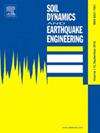AI-assisted analytical model of seismic displacement estimation for frictional isolated bridge portfolios under pulse-like ground motions
IF 4.2
2区 工程技术
Q1 ENGINEERING, GEOLOGICAL
引用次数: 0
Abstract
Accurate bearing displacement assessment is crucial for frictional isolated bridges under pulse-like ground motions. In order to cope with the efficiency requirement brought by large-scale bridge portfolio estimation, the artificial intelligence (AI) method, a powerful tool to address multi-parameter issues, is widely adopted in seismic performance analysis for bridge networks. However, the traditional machine learning (TML) method pursues the overall prediction performance, the prediction effect in sensitive intervals caused by pulse-effect can not be assured. To face this challenge, this study proposed an AI-assisted analytical (AIA) method, which owns the characteristics of high efficiency, high accuracy and clear physical meaning. In the first step of the AIA method, the relationship between primary factor (pulse period) and output (seismic displacement) is established through an analytical model; in the second step, the undetermined parameters of the analytical model are estimated with the assistance of the AI method. The results indicate that the AIA model only requires 0.1 times data for model training and achieves overall predictive performance similar to TML methods. Moreover, the predictive effect of the AIA model in the sensitive range is greatly improved compared to the TML method. Finally, based on AIA method, an effective seismic fragility prediction method is proposed for frictional isolated bridge networks. The fragility curves illustrated by AIA method and FE analysis are in good agreement, which exhibited the satisfactory efficiency of the proposed AIA method.
人工智能辅助分析模型:脉冲地动下摩擦孤立桥梁组合的地震位移估算
精确的支座位移评估对于脉冲地动下的摩擦隔震桥梁至关重要。为了应对大规模桥梁组合估算带来的效率要求,人工智能(AI)方法作为解决多参数问题的有力工具,在桥梁网络抗震性能分析中被广泛采用。然而,传统的机器学习(TML)方法追求的是整体预测性能,对脉冲效应引起的敏感区间的预测效果无法保证。面对这一难题,本研究提出了一种人工智能辅助分析(AIA)方法,该方法具有效率高、精度高、物理意义明确等特点。AIA 方法的第一步是通过分析模型建立主因子(脉冲周期)与输出(地震位移)之间的关系;第二步是利用人工智能方法对分析模型中的未确定参数进行估计。结果表明,AIA 模型只需要 0.1 倍的数据进行模型训练,就能达到与 TML 方法相似的整体预测性能。此外,与 TML 方法相比,AIA 模型在敏感范围内的预测效果有很大提高。最后,基于 AIA 方法,提出了一种有效的摩擦孤立桥网地震脆性预测方法。AIA 方法和 FE 分析得出的脆性曲线具有良好的一致性,这表明所提出的 AIA 方法具有令人满意的效率。
本文章由计算机程序翻译,如有差异,请以英文原文为准。
求助全文
约1分钟内获得全文
求助全文
来源期刊

Soil Dynamics and Earthquake Engineering
工程技术-地球科学综合
CiteScore
7.50
自引率
15.00%
发文量
446
审稿时长
8 months
期刊介绍:
The journal aims to encourage and enhance the role of mechanics and other disciplines as they relate to earthquake engineering by providing opportunities for the publication of the work of applied mathematicians, engineers and other applied scientists involved in solving problems closely related to the field of earthquake engineering and geotechnical earthquake engineering.
Emphasis is placed on new concepts and techniques, but case histories will also be published if they enhance the presentation and understanding of new technical concepts.
 求助内容:
求助内容: 应助结果提醒方式:
应助结果提醒方式:


